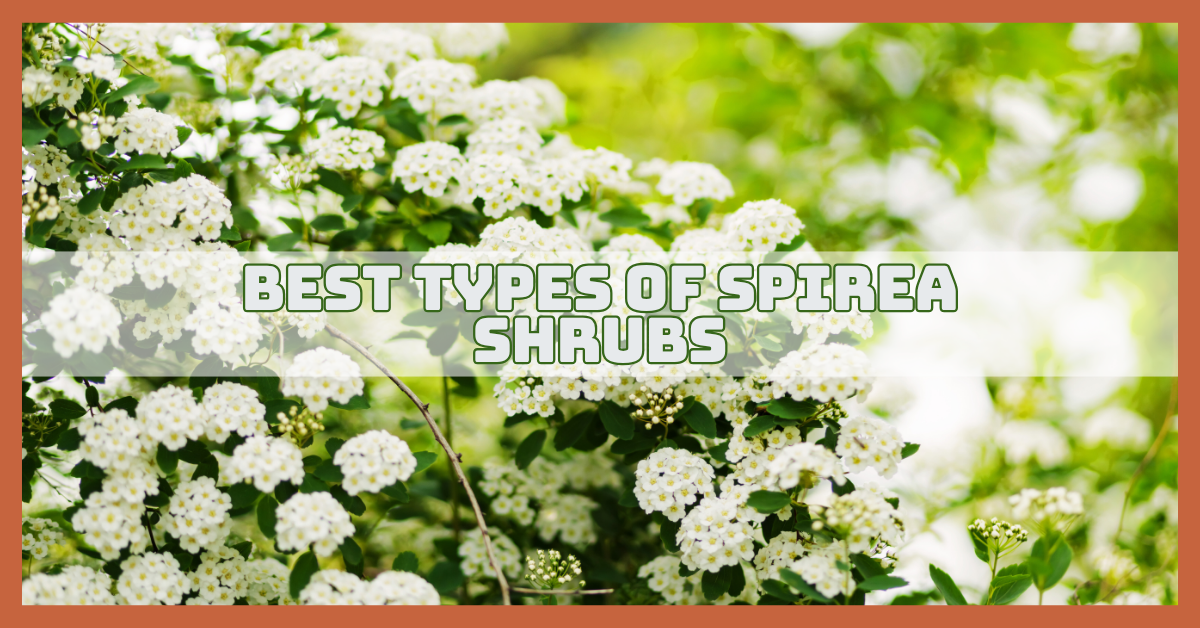Best Types Of Spirea Shrubs For Easy Gardening
Gardeners love spirea shrubs for their effortless beauty, adaptability, and low-maintenance nature. Whether you're designing a cottage-style garden, creating a border, or looking for a fuss-free flowering hedge, spireas are an excellent choice.
With many varieties available, each offering its unique bloom style, foliage colour, and size, there’s a spirea shrub to suit almost any landscape.
In this comprehensive guide, we’ll explore the many types of spirea shrubs, their key characteristics, how to care for them, and how to incorporate them into your garden design.
What Is A Spirea Shrub?
A spirea shrub is a beautiful, low-maintenance deciduous plant known for its graceful arching branches and vibrant flower clusters.
Spirea is a member of the Rose family (Rosaceae) and comes in a variety of forms. Depending on the type, it blooms in spring or summer and can be pink, white, or red.
These hardy shrubs range in size from compact mounds to taller, sprawling forms, making them perfect for borders, hedges, or mass plantings.
One of spirea’s most charming traits is its ability to provide multi-season interest—many varieties offer colourful foliage in spring and stunning autumn tones as the season changes.
Spireas are fast-growing, attract pollinators, and thrive in full sun with minimal care, making them a favorite among beginner and expert gardeners alike.
Whether you're designing a cottage garden or a modern landscape, the spirea’s blend of beauty, versatility, and resilience makes it an excellent choice for any outdoor space.
Why Choose Spirea Shrubs?
Looking for a shrub that’s easy to grow, blooms colourfully, and adds colour through multiple seasons? Spirea shrubs might be exactly what your garden needs.
Here’s why these versatile plants are a favourite among gardeners of all experience levels:
1. Low Maintenance
Spirea shrubs are ideal for gardeners seeking ease. Once established, they need minimal watering and thrive with little attention.
They’re also naturally resistant to pests and diseases, and pruning is simple, usually just to shape or remove spent blooms.
2. Long Bloom Time
Spireas offer extended flowering periods, with some varieties blooming in early spring and others continuing into late summer.
This prolonged bloom time ensures your garden stays colourful and lively for months, attracting admiration from both people and pollinators alike.
3. Attractive Foliage
Beyond their flowers, spireas shine with ever-changing foliage. New leaves may emerge in shades of red or bronze, mature to green or gold, and transform again in fall with vibrant hues of orange, yellow, or burgundy, offering seasonal visual interest.
4. Pollinator Friendly
Spirea’s abundant, nectar-rich flowers draw in bees, butterflies, and other helpful insects. This makes them a great addition to pollinator gardens, supporting local ecosystems and encouraging natural biodiversity right in your backyard with little effort required.
5. Versatile Landscaping Use
Spireas adapt beautifully to various garden styles. Use them for foundation planting, hedges, mixed borders, or mass plantings. Dwarf varieties work well in containers, making them suitable for patios or balconies as well as traditional garden beds.
6. Fast Growing
Need quick garden results? Spireas grow rapidly and fill spaces efficiently. Their quick establishment makes them perfect for covering bare spots, defining spaces, or forming hedges within a single growing season, all while staying manageable in size and shape.
7. Wide Variety Of Options
With numerous species and cultivars, spirea offers an incredible range of sizes, bloom colours, and foliage tones. Whether you prefer a compact, gold-leaved variety or a sprawling spring bloomer, there’s a spirea to match every landscape vision.
Popular Types Of Spirea Shrubs
Spirea shrubs come in many beautiful varieties, each offering unique blooms, foliage, and growth habits. Whether you're looking for bold colour, elegant arching branches, or compact forms, there’s a perfect spirea for every garden style.
1. Japanese Spiraea (Spiraea japonica)
- Also known as: Japanese Meadowsweet
- Bloom time: Late spring to summer
- Zones: 4–9
Features
Japanese spirea is one of the most popular types of spirea shrubs, valued for its vibrant blooms and colourful, season-changing foliage.
It produces abundant pink, red, or white flowers that attract pollinators and brings long-lasting colour to gardens. Many cultivars offer foliage that shifts through stunning shades—emerging in bronze or red, turning green or gold in summer, and often finishing with a brilliant fall display.
Its neat, mounding habit makes it ideal for borders, mass plantings, or container use. With numerous dwarf and compact varieties available, Japanese spirea suits both small and large landscapes, offering beauty with minimal upkeep.
How To Grow
Japanese spirea grows best in USDA hardiness zones 4–9. Plant it in full sun for vibrant blooms and colourful foliage, though it can tolerate partial shade.
Although it may grow in many types of soil, it prefers soil that drains well. Water regularly during the first growing season to help establish a deep root system.
Once mature, it becomes drought-tolerant and needs only occasional watering. To sculpt the plant and promote new growth, prune in the late winter or early spring.
You can prolong the flowering period by deadheading spent flowers. It's an easy-care shrub perfect for low-maintenance landscapes.
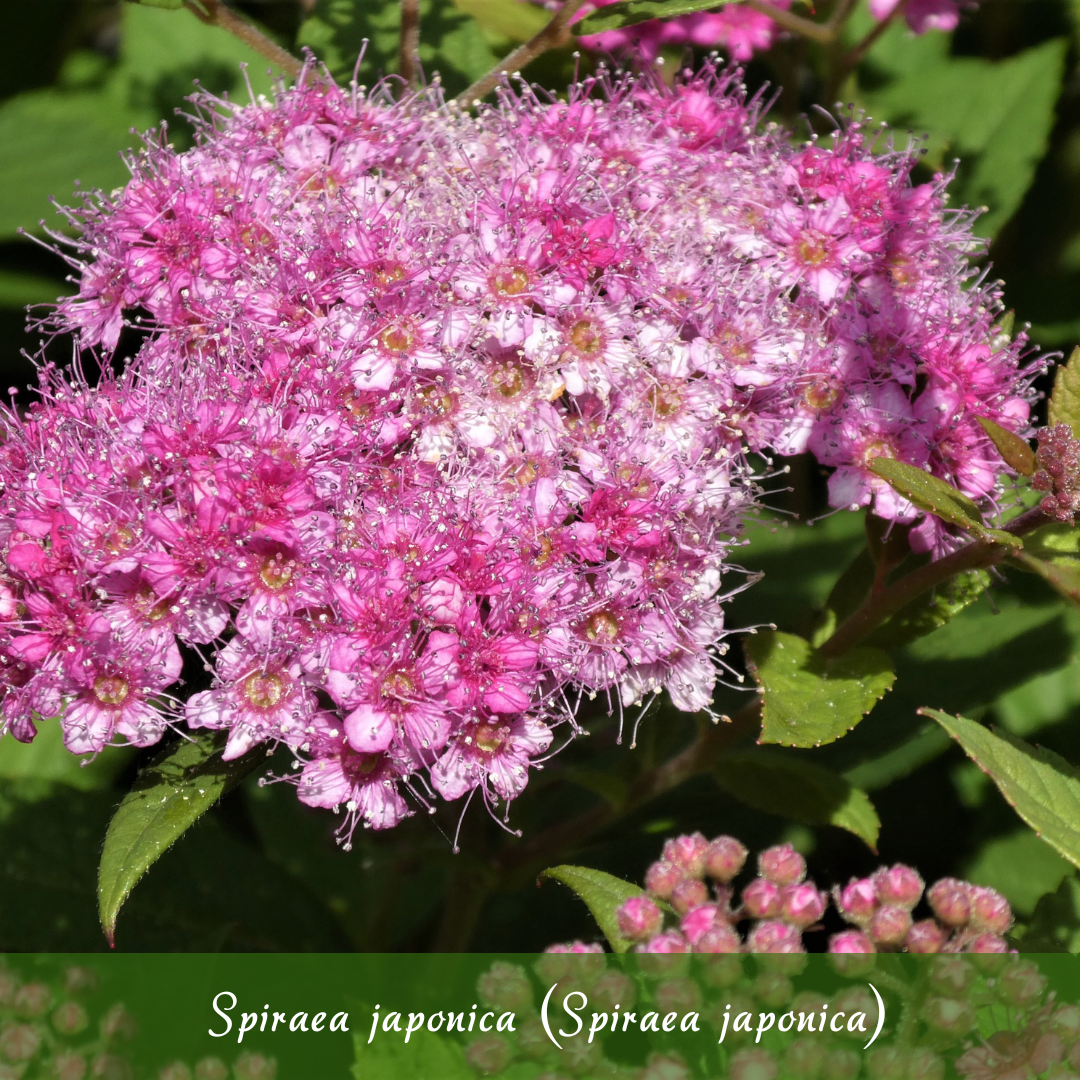
2. Vanhoutte Spirea / Bridal Wreath (Spiraea × vanhouttei)
- Also known as: Vanhoutte Spirea, Bridal Wreath Spirea
- Bloom time: Mid to late spring
- Zones: 3–8
Features
Vanhoutte spirea is a classic hybrid shrub admired for its cascading, fountain-like branches covered in a blanket of small white flowers each spring.
The graceful arching habit gives it a soft, romantic appearance that suits cottage-style and traditional landscapes. It grows 6–8 feet tall and wide, making it ideal as a flowering hedge, backdrop, or specimen plant.
Its bluish-green foliage provides texture and remains attractive throughout the summer, with some yellow or reddish hues in fall. Long-lived and easy to grow, this spirea creates a stunning floral display that draws attention year after year.
How To Grow
Vanhoutte spirea thrives in USDA zones 3–8. Plant it in full sun to light shade for optimal flowering and growth. It prefers well-drained soil and can tolerate clay or loamy conditions.
Water regularly during the first year; once established, it is moderately drought-tolerant. Prune after blooming in late spring to shape the plant and remove spent branches.
Early spring pruning should be avoided because this variety blooms on old wood. Fertilizing in early spring is optional but may enhance vigour. Its low-maintenance nature makes it perfect for hedges, mass plantings, or mixed borders.
3. Double Bridal Wreath Spirea (Spiraea prunifolia)
- Also known as: Bridal Wreath Spirea, Double Bridal Wreath
- Bloom time: Mid to late spring
- Zones: 4–8
Features
Spiraea prunifolia is one of the classic types of spirea shrubs, cherished for its abundant double white flowers and graceful, cascading branches.
Growing 4 to 8 feet tall, it creates a dramatic, cascading effect perfect for borders or natural screens. Its delicate, finely textured foliage is bright green, turning golden to reddish in fall.
This old-fashioned favourite combines charm and elegance, offering a fragrant, eye-catching display. It’s hardy, fast-growing, and provides multi-season interest, making it a treasured addition to cottage and formal gardens alike.
How To Grow
Bridal Wreath Spirea thrives in USDA zones 4–8. Plant it in full sun for the best flower production, although it tolerates light shade.
It prefers well-drained soil but adapts to various soil types, including clay. Water regularly during establishment, then reduce frequency once mature.
When it blooms on old wood, it should be pruned right away to preserve shape and promote healthy development. Mulching helps conserve moisture and protect roots.
This shrub is low-maintenance, deer-resistant, and an excellent choice for gardeners seeking springtime elegance with minimal care.
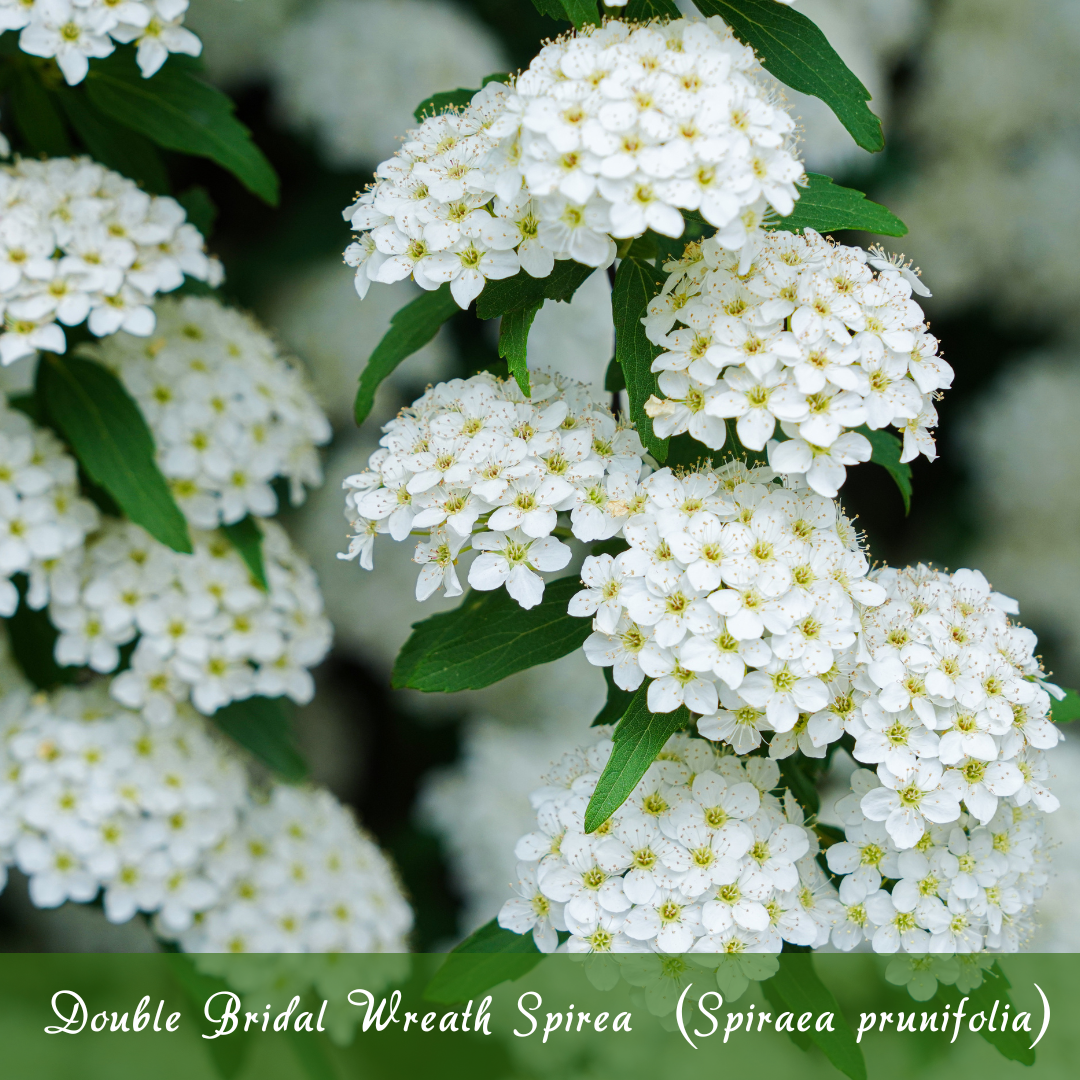
4. Thunberg Spirea (Spiraea thunbergii)
- Also known as: Thunberg’s Spirea, Baby’s Breath Spirea
- Bloom time: Early spring
- Zones: 4–8
Features
Thunberg spirea is a graceful, early-blooming shrub known for its delicate, airy appearance. It produces masses of small, white flowers that cover its fine-textured, slender branches in early spring, creating a soft, cloud-like effect.
It has narrow, lance-shaped leaves that turn yellow in the fall and a naturally arching habit. It usually reaches a height of 3 to 5 feet.
This shrub adds early-season brightness to gardens and is valued for its elegant form, light foliage, and long-lasting floral display, making it perfect for borders, foundation plantings, or naturalized areas.
How To Grow
Thunberg spirea grows best in USDA zones 4–8. It can tolerate some shade but loves full light. Although it grows well in sandy or loamy soils, it is best planted in well-drained soil.
To establish roots, water often throughout the first growing season. As it grows, it becomes more drought-tolerant and requires less water. To shape the shrub and get rid of any weak or dead growth, prune it after it has flowered.
This spirea adds early spring appeal to any landscape and requires little care because it is deer-resistant and low-maintenance.
Turn Your Passion for Nature Into Income
🌿 Whether you love gardening, caring for animals, or exploring holistic living,
You can share your knowledge online and earn from it.
Discover how nature lovers are growing their passions into meaningful, income-generating blogs. 👇
5. Douglas Spirea (Spiraea douglasii)
- Also known as: Western Spirea, Douglas’ Spirea
- Bloom time: Summer (mid to late summer)
- Zones: 4–8
Features
Douglas spirea is one of the native types of spirea shrubs prized for its tall, upright growth and vibrant rose-pink flowers that attract pollinators in moist garden areas.
It can reach heights of 3 to 6 feet and grows best in wet areas like marshes or the banks of streams. Its lance-shaped green leaves often turn reddish-purple in the fall, adding seasonal interest.
A great addition to landscapes that are wildlife-friendly, this spirea draws pollinators like bees and butterflies. Its natural, somewhat wild appearance suits naturalized or native plant landscapes.
How To Grow
Douglas spirea thrives in USDA zones 4–8 and prefers moist, well-drained soil, but tolerates wetter conditions better than many spireas.
Watering must be done frequently, especially when it's dry. For form retention and healthy development, prune in late winter or early spring.
This shrub is hardy and low-maintenance, ideal for rain gardens, naturalized areas, or moist borders where it can spread and fill space while supporting local pollinators.

6. Birchleaf Spirea (Spiraea betulifolia)
- Also known as: Birchleaf Meadowsweet
- Bloom time: Late spring to early summer
- Zones: 3–7
Features
Birchleaf spirea is one of the versatile types of spirea shrubs, appreciated for its compact form, attractive foliage, and delicate white flowers. Growing 2 to 4 feet tall, it forms a neat, rounded mound perfect for small gardens or borders.
Its foliage often turns golden yellow or reddish in fall, adding vibrant seasonal colour. This spirea is valued for its tidy habit, ease of care, and ability to thrive in colder climates.
It’s also deer-resistant and an excellent choice for wildlife gardens, attracting pollinators while providing year-round interest.
How To Grow
Birchleaf spirea grows best in USDA zones 3–7. Although it can tolerate poor or rocky soils, it likes full sun to moderate shade and well-drained soil.
Water frequently throughout the first growth season, then less regularly after it has established itself. Prune after flowering to maintain shape and promote healthy growth.
Mulching helps retain moisture and protect roots during winter. This shrub is low-maintenance, drought-tolerant, and adaptable, making it a versatile option for foundation plantings, borders, or naturalized landscapes.
7. Snowmound Spiraea (Spiraea nipponica ‘Snowmound)
- Also known as: Snowmound Spirea
- Bloom time: Late spring to early summer
- Zones: 4–8
Features
Snowmound is one of the popular types of spirea shrubs known for its dense white blooms and graceful, rounded form that enhances any garden setting.
Growing 3 to 5 feet tall and wide, it forms a thick, arching mound with bright green foliage that provides a fresh look throughout the growing season.
Its graceful, cascading branches create a soft, elegant silhouette in the garden. ‘Snowmound’ is prized for its reliability, long bloom period, and ability to fit beautifully into borders, mass plantings, or foundation beds.
How To Grow
In USDA zones 4–8, “Snowmound” grows well and blooms best in full sun as opposed to partial shade. It adapts well to a variety of soil types but grows best in well-drained, fertile soil. To establish roots, water often during the first growing season.
Once established, water less frequently. This variety is low-maintenance, drought-tolerant, and resistant to most pests and diseases, making it an excellent choice for gardeners seeking a dependable, showy shrub.
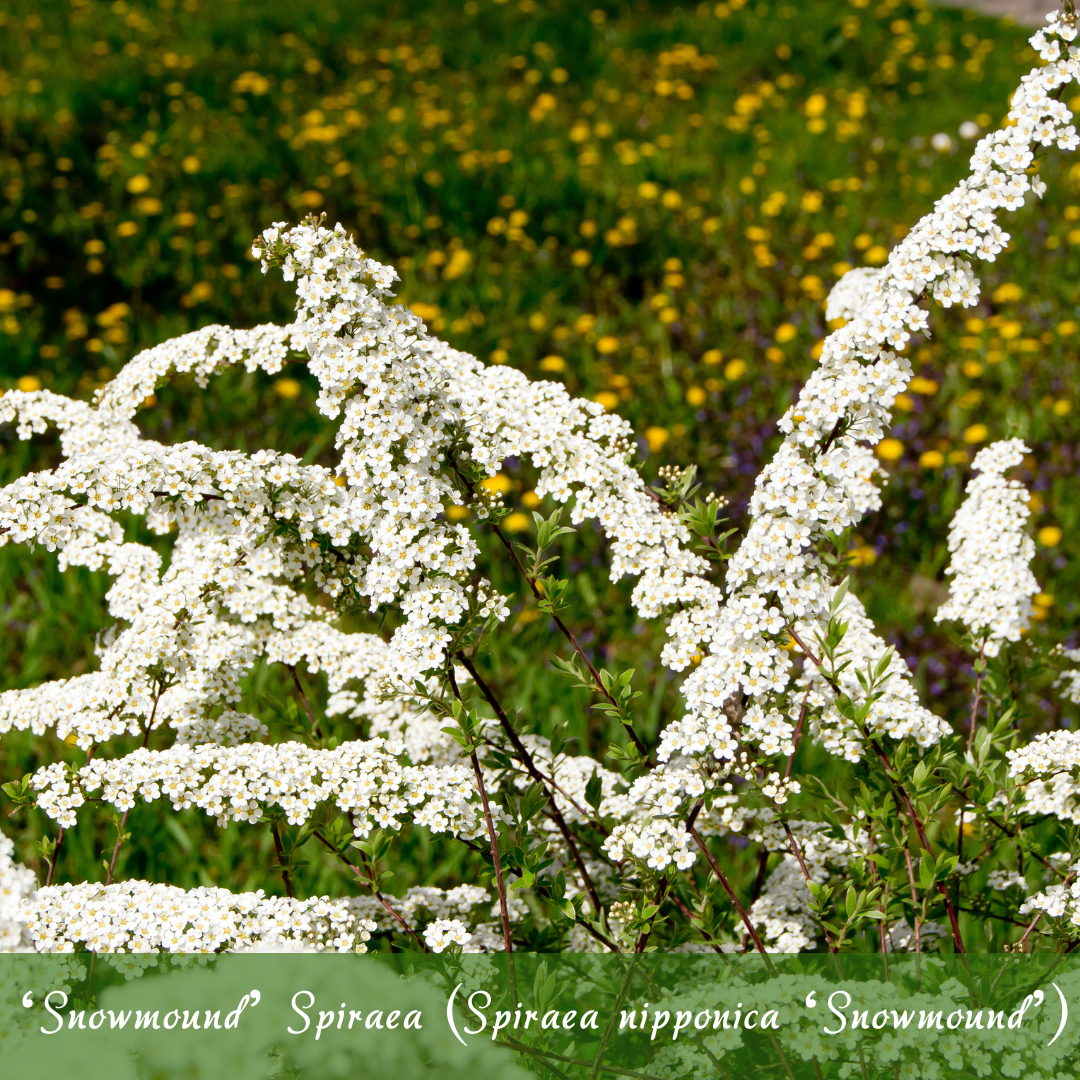
8. Steeplebush (Spiraea tomentosa)
- Also known as: Hardhack, Woolly Spirea
- Bloom time: Mid to late summer
- Zones: 3–8
Features
Steeplebush is one of the unique types of spirea shrubs valued for its tall, cone-shaped pinkish flowers and suitability for moist, pollinator-friendly gardens.
It usually reaches a height of 2 to 4 feet and has a clumping, somewhat erect habit. Its leaves are oval-shaped and have a soft, fuzzy texture, adding a unique texture to the garden.
This shrub thrives in moist, acidic soils and is often found in wetlands and boggy areas. For pollinator-friendly gardening, it is an excellent choice because it draws bees and butterflies.
How To Grow
Steeplebush grows best in USDA zones 3–8. Unlike many spireas, it can withstand wetter circumstances better, but it prefers full sun over partial shade and moist, acidic, well-drained soils.
Regular watering is essential, especially during dry spells. Prune in late winter or early spring to control size and shape.
This shrub is hardy, low-maintenance, and thrives in rain gardens, wetlands, or naturalized landscapes, offering both beauty and ecological value.
9. White Meadowsweet (Spiraea alba)
- Also known as: White Spirea, Meadow Spirea
- Bloom time: Summer (mid to late summer)
- Zones: 3–8
Features
White Meadowsweet is a distinctive type of spirea shrub known for its fragrant white flowers and ability to thrive in moist, naturalized garden settings. Growing 3 to 4 feet tall, it thrives in damp soils, making it ideal for rain gardens or naturalized areas.
The narrow, lance-shaped green leaves provide a lush backdrop, turning yellowish in fall. This spirea attracts butterflies and bees, supporting local pollinators.
It's a great addition to many garden settings due to its beautiful flower spikes and ability to withstand moist circumstances.
How To Grow
White Meadowsweet grows best in USDA zones 3–8. Although it can withstand little shade, it likes full sun, particularly in warmer climates. This shrub thrives in moist, well-drained soils and can tolerate wetter conditions better than many other spireas.
Regular watering is essential during dry periods to keep the plant healthy. After flowering, trim sparingly to preserve shape and promote new development.
White Meadowsweet is low-maintenance and suitable for rain gardens, naturalized landscapes, or moist borders where it adds vertical interest and supports pollinators.
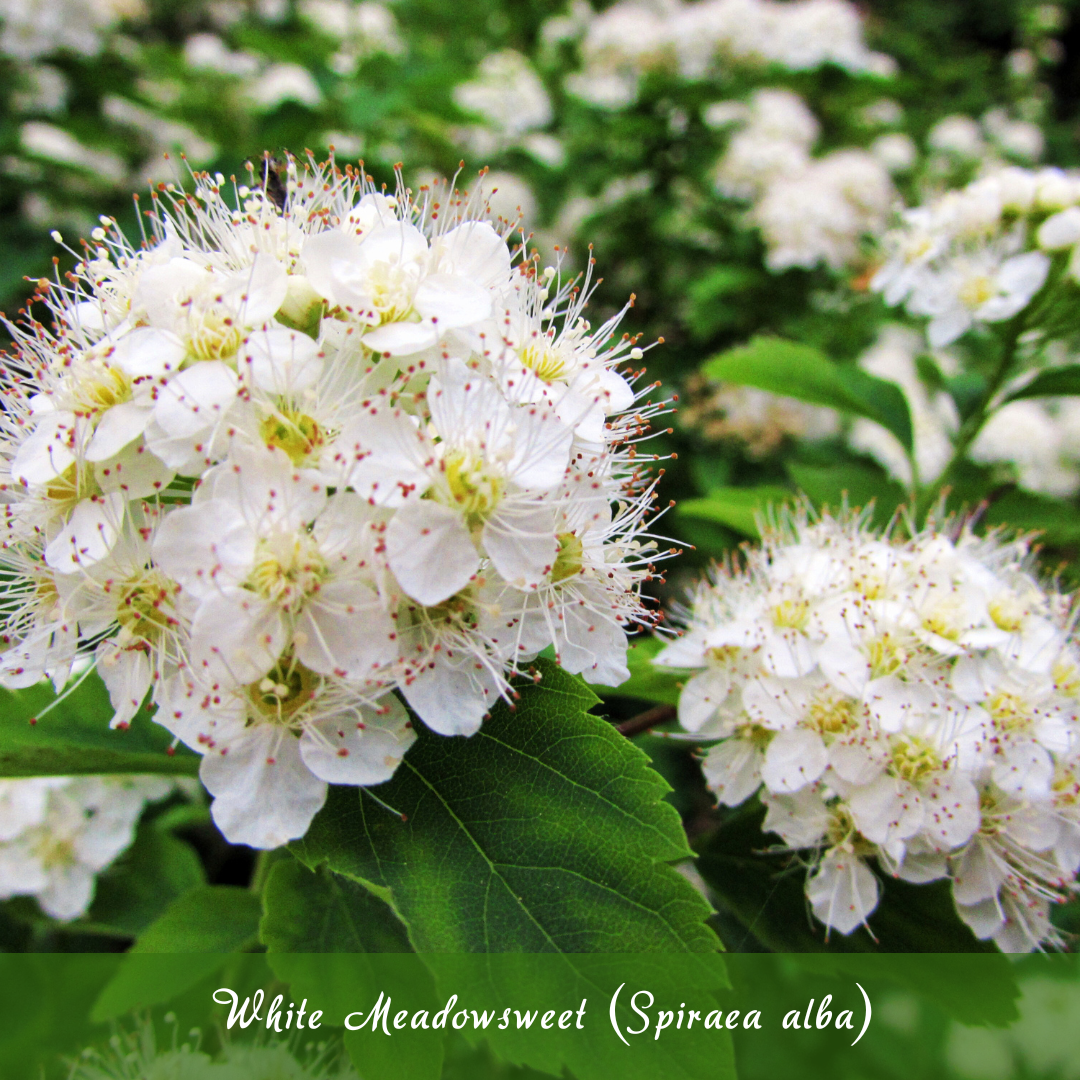
10. Neon Flash Spirea (Spiraea japonica ‘Neon Flash’)
- Also known as: Neon Flash Japanese Spirea
- Bloom time: Summer
- Zones: 4–8
Features
‘Neon Flash’ is a vibrant, compact cultivar of Japanese spirea known for its striking red-orange new foliage that fades to bright golden-yellow, adding bold colour all season long.
Its abundance of deep pink flower clusters throughout the summer draws pollinators such as butterflies and bees. Its tidy, rounded shape makes it ideal for borders, containers, and mixed garden beds, and it grows 2 to 3 feet tall and broad.
This cultivar is prized for its eye-catching foliage and continuous blooms, offering year-round interest and easy care for gardeners.
How To Grow
‘Neon Flash’ thrives in USDA zones 4–8. It prefers full sun for the brightest foliage and best flowering, but tolerates partial shade. Plant in well-drained, fertile soil and water regularly during the first growing season.
Once established, it is moderately drought-tolerant. Early spring pruning should be done sparingly to preserve shape and promote new growth.
This low-maintenance shrub resists pests and diseases, making it an excellent choice for colourful, hassle-free landscaping.
Conclusion
Spirea shrubs offer incredible variety, beauty, and versatility for any garden. The wide range of types of spirea shrubs ensures gardeners can find the perfect variety to add beauty, colour, and versatility to any landscape.
Easy to grow and low-maintenance, these shrubs provide long-lasting colour, attract pollinators, and thrive in many conditions.
Whether used as borders, hedges, or focal points, spireas bring charm and elegance with minimal effort, making them a top choice for gardeners everywhere.
I trust you enjoyed this article on the Best Types Of Spirea Shrubs For Easy Gardening. Please stay tuned for more inspiring guides, helpful tips, and ideas to help you live closer to nature every day.
Take care!
— JeannetteZ
💬 Your Opinion Is Important To Me
Do you have thoughts, ideas, or questions? I’d love to hear from you. Please leave your comments below or email me directly at Jeannette@Close-To-Nature.org.
📚 More Nature-Inspired Reads
Explore more ways to connect with nature, nurture your pets, and live in harmony with the world around you 🌿

